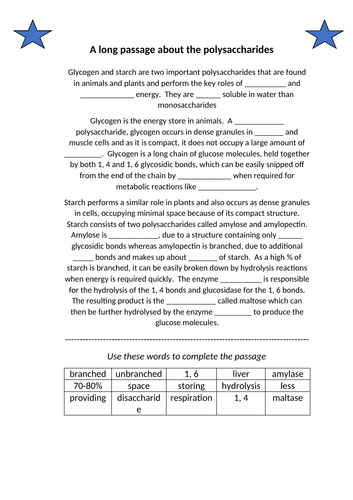





This fully-resourced lesson explores how glucose as well as the other respiratory substrates, such as lipids and proteins, can enter the respiratory pathway and therefore can be respired to produce molecules of ATP. The engaging PowerPoint and accompanying resources have been designed to cover points 5.2.2 (j) and (k) of the OCR A-level Biology A specification which states that students should know the difference in the relative energy values of carbohydrates, lipids and proteins and be able to use and interpret the respiratory quotient.
This lesson has been written to challenge current understanding as well as the knowledge of glycolysis, the link reaction and Krebs cycle and so contains regular prior knowledge checks which come in a range of forms. Students will learn that lipids and proteins can be used as respiratory substrates and will recognise the different ways that they enter the respiratory pathway. A quick quiz competition is used to introduce the mean energy value for carbohydrates and students are challenged to predict how the values for lipids and proteins will compare. As a result, students will recognise that a greater number of hydrogen atoms results in a greater availability of protons to form the chemiosmotic gradient to fuel the production of ATP. The rest of the lesson focuses on the calculation of the respiratory quotient and time is taken to look at how the result can be interpreted to determine which substrates were respired.
Get this resource as part of a bundle and save up to 33%
A bundle is a package of resources grouped together to teach a particular topic, or a series of lessons, in one place.
Module 5.2: Photosynthesis & Respiration (OCR A-level Biology A)
Photosynthesis and respiration are two of the most commonly-assessed topics in the terminal A-level exams but are often poorly understood by students. These 14 lessons have been intricately planned to contain a wide range of activities that will engage and motivate the students whilst covering the key detail to try to deepen their understanding and includes exam-style questions so they are prepared for these assessments. The following specification points in modules 5.2.1 and 5.2.2 of the OCR A-level Biology A course are covered by these lessons: * The structure of a chloroplast and the sites of the two main stages of photosynthesis * The light-dependent stage of photosynthesis * The fixation of carbon dioxide and the light-independent stage of photosynthesis * The uses of triose phosphate * Factors affecting photosynthesis * The need for cellular respiration * The structure of the mitochondrion * The process and site of glycolysis * The link reaction and its site in the cell * The process and site of the Krebs cycle * The importance of coenzymes in cellular respiration * The process and site of oxidative phosphorylation * The chemiosmostic theory * The process of anaerobic respiration in eukaryotes * The relative energy values of carbohydrates, lipids and proteins as respiratory substrates * The use of the respiratory quotient Due to the detail of these lessons, it is estimated that it will take in excess of 2 months of A-level lessons to cover this module If you would like to sample the quality of the lessons, download the uses of triose phosphate, link reaction and respiratory substrates lessons as these have been shared for free
Module 5.2.2: Respiration (OCR A-level Biology A)
All 9 of the lessons included in this bundle are fully resourced and have been designed to cover the detailed content of module 5.2.2 (Respiration) of the OCR A-Level Biology A specification. The following specification points are covered by this bundle of lessons: * The need for cellular respiration * The structure of the mitochondrion * The process and site of glycolysis * The link reaction and its site in the cell * The process and site of the Krebs cycle * The importance of coenzymes in cellular respiration * The process and site of oxidative phosphorylation * The chemiosmotic theory * The process of anaerobic respiration in eukaryotes * The difference in the relative energy values of carbohydrates, lipids and proteins * The use and interpretation of the respiratory quotient All of the lessons are detailed and engaging and contain regular progress checks so that students can assess their understanding of the current topic as well as prior knowledge checks to enable links between topics and modules to be seen It is estimated that these lessons will cover in excess of a month's A-level Biology teaching time
Something went wrong, please try again later.
This is fantastic!! An excellent lesson that uses prior knowledge application as a way to navigate new learning. Well scaffolded and up to date with current specification. I wasn't entirely sure about the first maths challenge (I got 17.8 using 64 RNA codons, but the answer was 15.8). Also not sure how BODMAS works with that challenge either which I think my students would moan about, but everything else was so much help. Thank you.
Thanks, this was really helpful with my planning - great resource :)
Again super resource with plenty for students to think about and engage with. thank you
Exciting lesson
It was challenging and such fun - thank you
Report this resourceto let us know if it violates our terms and conditions.
Our customer service team will review your report and will be in touch.